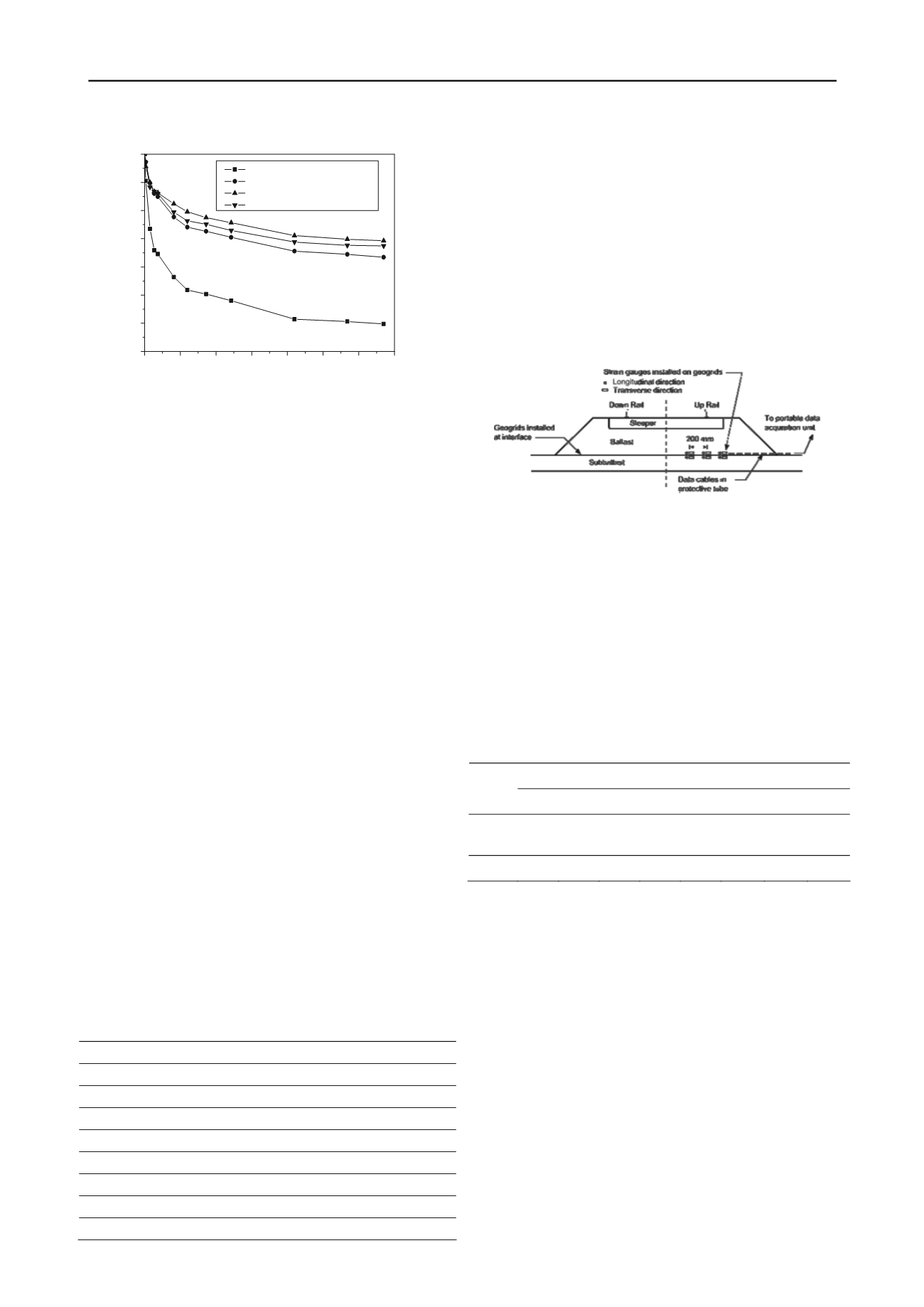
1285
Technical Committee 202 /
Comité technique 202
Figure 4. In-situ response of the ballast layer: lateral deformations (data
sourced from Indraratna et al. 2010).
3.3
Lateral ballast deformations
Average lateral deformations of ballast are plotted against
y high
indicate
o investigate the performance of different types of
study was also undertaken on an
instrumented track se
Singleton,
Newcastle.
4.1
Site geology and
nstruction
Nine experimental se
ere included in the trial track
while it was under con
, on three diffe
of sub-
grades, including (i) th
ely soft gener
vial
silt clay deposit (S
1-4 and Sec
the
intermediate cut siltsto
tions 5 and
C
),
he stiff
reinforced concrete bri
k supported by piled abutment
(Section B), as shown in Table 2. Further details of track
construction and material specifications c
und in
Indraratna et al. (2012c).
the number of load cycles (
N
) in Figure 4. The recycled ballast
with moderately graded particle size distribution (
C
u
= 1.8)
showed less lateral deformations compared to the very uniform
fresh ballast (
C
u
= 1.5). Recycled ballast often shows less
breakage because the individual particles are more rounded
which prevents high angular corner breakage caused b
in Figure 4
stress concentrations. The results presented
that the geocomposite reduced lateral deformation of fresh
ballast by about 49 % and that of recycled ballast by 11 %. The
apertures of the geogrid offered strong mechanical interlocking
with the ballast. The capacity of the ballast to distribute loads
was improved by the placement of the geocomposite, which
substantially reduced settlement under high repeated loading.
4 USE OF GEOSYNTHETICS FOR STABILISING A
BALLASTED TRACK: SINGLETON CASE STUDY
T
geosynthetics for improving the overall track stability under in
situ conditions, an extensive
ctions in
near the City of
track co
ctions w
struction
rent types
e relativ
ections
al fill and allu
tion
A
), (ii)
y
ne (Sec
and (iii) t
dge dec
a
an be fo
Table2. Reinforcement at experimental sections using geogrids,
geocompolistes, and shock mats.
Section
Location
Reinforcement
A
234.75
-
1
234.66
Geogrid 1
2
234.40
Geogrid 2
3
234.22
Geogrid 3
4
234.12
Geocomposite
B
232.01
4.2
Track instrumentation
Shock mat
C
228.50
-
5
228.44
Geogrid 3
The strain gauges were installed in groups, 200 mm apart, and
ds in both longitudinal and
5.
ls o k i
me
n
str
uge
4.3
ared,
grade
ncrete
on the top and bottom sides of the gri
transverse directions (Figure 5). The strain gauges were of a
post-yield type suitable to measure strains in the range of 0.1 to
15%. Two pressure cells were installed at Sections 1, 5,
A
and
C
. At these locations, one pressure cell was installed at the
sleeper-ballast and another at the ballast-sub-ballast interface.
At Section
B
, three pressure cells were installed at the synthetic
mat-deck interface. Settlement pegs were also installed at the
sleeper-ballast and ballast-sub-ballast interfaces to measure the
vertical deformations of the ballast layer.
Figure Detai
f trac nstru ntatio using ain ga s.
Vertical ballast deformations
The settlements (
s
v
) and vertical strains (
v
) of the ballast layer
after 2.3
10
5
load cycles are reported in Table 3. The vertical
settlements of sections with reinforcement are generally smaller
than those without reinforcement. This observation is mainly
attributed to the effective interlocking between the ballast
particles and grids, thus inducing increased track confinement
as explained earlier. When sections
a
,
b
, and
c
are comp
the results indicate that
s
v
and
v
are larger when the sub
stiffness becomes smaller, i.e.
S
is smallest on the co
v
bridge deck and largest at the alluvial deposit.
Table 3. Vertical deformation and strain of ballast after 2.3
10
5
load
cycles.
Instrumented section details
1
2
3
4
5
A
B
C
S
v
(mm)
16.3
21.2
14.8
16.0
16.3
23.8
8.8
17.8
v
(%)
5.4
7.1
4.9
5.3
5.4
7.9
2.9
5.9
It is also observed that the geogrid is more effective in terms
ported by Ashmawy and
Bourdeau (1995) thorough
geogrid at
Section 3 performed better, although the tensile strength did not
differ much with the other types.
is is a
um aperture size (40 mm) which would enable better
cking between the b parti
d the rid.
4.4
Strains accumulation in
geocomposites
ins after
of reducing track settlement for relatively weak subgrades.
Similar observations have been re
full scale testing. The
Th
ttributed to the
optim
interlo
allast
cles an geog
geogrids &
Accumulated longitudinal (
l
) and transverse (
t
) stra
2.3
10
5
load cycles are given in Table 4. The transverse strains
were generally larger than the longitudinal strains, and this is
attributed to the ease of lateral spreading of the ballast layer
upon loading. It was also observed that
l
and
t
were mainly
influenced by the subgrade deformations. The strains of geogrid
at Section 4 were relatively large although its higher stiffness
could have resulted in smaller strains. This is because, the
thicker general fill underwent large lateral deformations shortly
after the track was commissioned. Induced transient strains in
both longitudinal and transverse directions due to the passage of
0
1x10
5
2x10
5
3x10
5
4x10
5
5x10
5
6x10
5
7x10
5
-14
-12
-10
-8
-6
-4
-2
-0
Average lateral deformation of ballast, (S
h
)
avg
(mm)
Fresh ballast (uniformly graded)
Recycled ballast (broadly graded)
Fresh ballast with geocomposite
Recycled ballast with geocomposite
Number of load cycles, N


